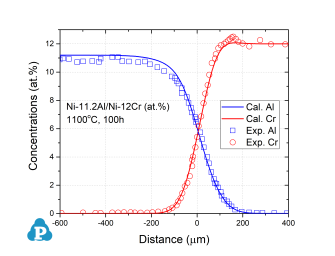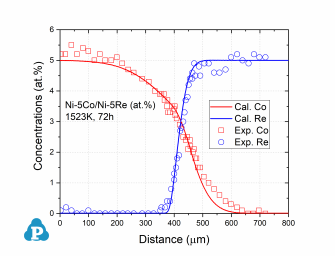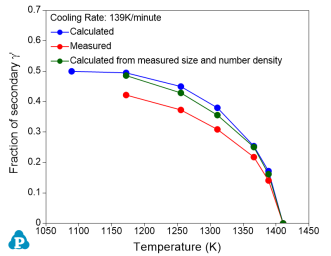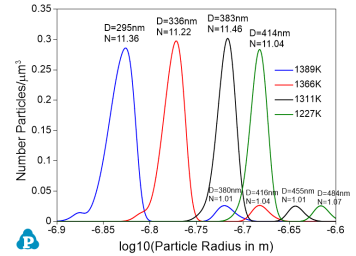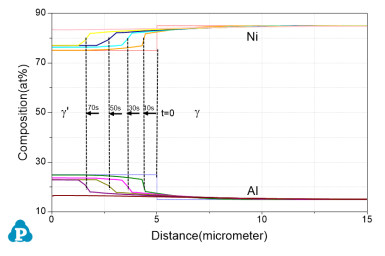Mobility Database
PanNi2024_MB is an atomic mobility database for Ni-based alloys, which is compatible with the PanNi2024_TH thermodynamic database and suitable for the simulation of diffusion-controlled phenomena using the PanDiffusion module, PanEvolution module, and/or PanSolidification module.
Phases
The atomic mobility within the Liquid, Bcc, Fcc, and Hcp solution phases are assessed in this database.
Self-diffusivity of Pure Elements
The self-diffusivity of an element is usually described by an analytical expression. For the stable crystal structures, these expressions can be obtained using the available experimental data, while those for the metastable/unstable states are usually estimated from those of the stable states. In the following tables, we use different color to represent different status:
| : |
Validated |
|
| : |
Estimated |
|
| : |
No data |
Assessed Systems
In addition to the assessed self-diffusivities shown above, the impurity diffusion data for all elements included in the current mobility database are also assessed. Moreover, chemical-diffusivities available in some binary and ternary systems are also used to assess the interaction parameters. These binary and ternary systems are listed below for the Bcc and Fcc phases.
Database Validation
The simulated concentration profiles of a series of Ni-base alloys are shown below to validate the current PanNi2024_MB database.
Applications
This mobility database is combined with the thermodynamic database for Ni-based superalloys, PanNi2024_TH, to simulate the diffusion-controlled phenomena of Ni-based superalloys. A few examples are given below.
Precipitation kinetics of Ni-based superalloys
The PanEvolution module was developed for the simulation of precipitation kinetics of multi-component alloys. It has been seamlessly integrated with the thermodynamic calculation engine of the Pandat™ software, and has been used to simulate the evolution of microstructure and the corresponding mechanical property responses to heat treatment of Ni-based superalloys. Below shows an example simulation performed for the LSHR alloy solutionized at supersolvus temperature 1463K for 20 minutes to dissolve γ' and homogenize the chemistry throughout the γ grain. These samples were then cooled at a rate of 11K/min or 139K/min to a predetermined temperature within the range of 1089K to 1411K, then quenched. The simulated γ' precipitates evolution is compared with experimental data as shown in Figure 3 and Figure 4. As is seen, the model calculated values agree well with those directly measured. The slow cooling rate leads to bimodal distribution of secondary γ' with much bigger particle size of secondary γ' (~3 times as big as the fast cooling rate) and slightly higher volume fraction of secondary γ'. The database used to do this simulation is the combined thermodynamic and mobility database of Ni-based alloys: PanNi_TH+MB. More information regarding to precipitation simulation can be found in PanEvolution module under the Software section.
Figure 3: Comparison between the simulated and the measured volume fractions of γ' with the cooling speed of 139K/m to different temperatures
Figure 4: Simulated number densities of γ' particles when cooling to various temperatures with the cooling speed of 11K/m
Dissolution of Ni-based superalloys
The PanDiffusion module was developed for the simulation of diffusion kinetics of multi-component alloys. In Figure 5, dissolution of γ' particle in Ni-Al binary system was simulated for demonstration. The initial matrix composition is Ni-15at.%Al and that of the γ' particle is set as Ni-25at.%Al at the beginning with the radius of 5μm. The simulated composition profiles at 1200 °C for different time are shown in Figure 5. One can see that the γ' particle can be completed dissolved within a few minutes at 1200 °C. In this simulation, the combined thermodynamic and mobility database of Ni-based superalloys, PanNi_TH+MB, is used. More information regading to diffusion simulation can be found in PanDiffusion module under the Software section.
[1996Eng] A. Engstrom and J. Agren, Assessment of diffusional mobilities in face-centered cubic Ni-Cr-Al alloys. Z. Metallkd, 1996. 87(2): 92-97.
[2014Liu] X.J. Liu, et al., Assessment of the atomic mobility for the fcc phase of Ni-Co-X (X=Re and Ru) system. Calphad, 45 (2014): 138-144.



